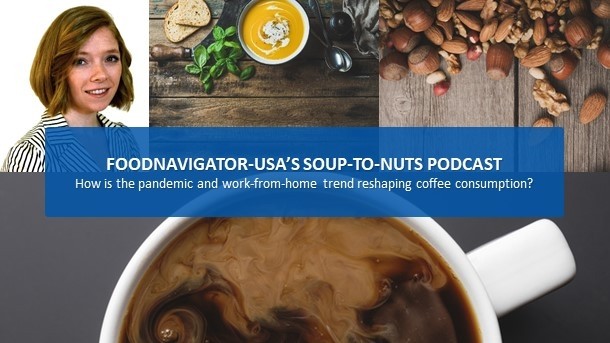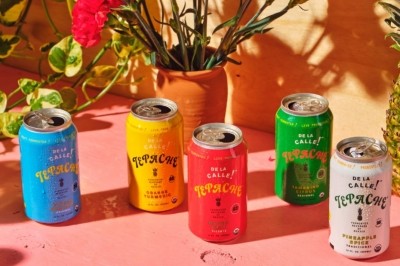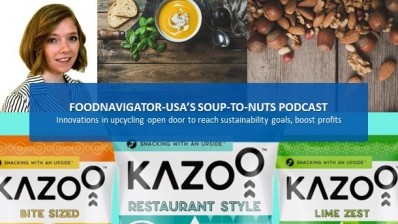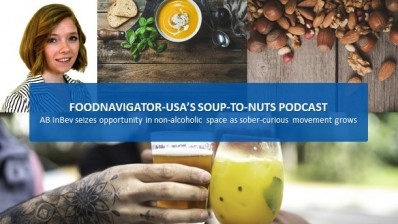Soup-to-Nuts Podcast: How has the pandemic and work-from-home trend impacted coffee consumption?

The recently released Fall 2021 edition of NCA’s long-running National Coffee Data Trends Research Series conducted in collaboration with the Specialty Coffee Association revealed that over the past year, coffee’s popularity in America rose, with 46% of 18- to 24-year-olds reporting that they drank coffee in the past day – a 10% increase from January 2021.
Likewise, coffee consumption in the past day among 25- to 39-year-olds reached a record high of 65%. Altogether, about 70% of Americans drink coffee.
Not only are more Americans drinking coffee, but according to the report, in the past year they became more adventurous in the types of coffee they reach for as they adjusted their rituals first to adapt to the at-home lifestyle enforced early in the pandemic and then again as offices, schools and shops reopened.
In this episode of FoodNavigator-USA’s Soup-To-Nuts podcast, NCA president and CEO William Murray explains how these shifts and the pandemic more generally are creating new opportunities for the coffee industry – including for players that cater to at-home consumption and those who operate in foodservice and more on-the-go settings.
Pulling on insights from NCA’s most recent survey, Murray also shares how emerging consumer preferences that go beyond taste and experience are reshaping the category. Finally, he offers an early glimpse at how the youngest generation is approaching coffee and what this might mean for the industry long-term.
[Editor’s note: Never miss an episode of FoodNavigator-USA’s Soup-To-Nuts podcast – subscribe today.]
NCA survey: Coffee is America’s ‘favorite’ beverage
For the coffee industry at large, the pandemic has brought mostly good news – but it has also brought change, which for some parts of the industry has been great and other parts less so.
The good news, as Murray explains, is that coffee remains Americans’ ‘favorite beverage’ – a position it has held for the past ten years and which helped buoy sales for at-home consumption during the pandemic.
Based on NCA’s survey of a representative group of Americans – not just coffee-drinkers – about 60% of Americans said they drank coffee the day before the survey – far more than those who drank tap water (47%), tea (47%), soda (39%) and juice (22%). When extended to the past week, about 70% of Americans said they drank coffee – helping to bolster its top positioning, Murray said.
The mixed news, however, is where and how Americans drank their coffee has changed, with at home consumption rising and away-from home consumption taking a significant hit during lockdowns. However, Murray says, over the past year that trend has begun to reverse.
“The good news for those of us in the coffee sector is the pandemic has not changed how much coffee people have been drinking,” but for coffee purveyors in the foodservice, hospitality or airline industry the picture is more complicated as most coffee is now consumed at home, Murray said.
About 70% of Americans drink coffee
About 85% of coffee drinkers have at least one cup at home, but during the lockdowns there was a 55% drop in people who drank coffee in their workplace, a 20% in convenience stores, a 50% drop in coffee orders at restaurants and coffee shops saw business drop by a third, according to NCA.
To offset these losses, coffee players in foodservice offered app ordering, which increased 46% between January 2020 and the fall survey, and drive-through options, which increased 15% in the same period.
As economies reopen and people safely return to their pre-pandemic habits, NCA saw an uptick in people who consumed coffee at work (55%), at an eating place (20%) and while commuting or traveling (9%).
One of the big questions about how the new normal will impact coffee consumption going forward hinges on how many people continue to do their jobs from home and how many return to their workplace.
This is where Murray says he sees opportunity. He explained workplaces increasingly are opting for touchless and single serve coffee machines that allow for safety and personalization. The long-term shift of more people working from home more often also is creating opportunities for the coffee industry to offer a more premium at-home consumption experience as
As a result, Murray said 23% of coffee drinkers purchased some type of new coffee machine to do something different with their coffee at home during the pandemic.
Cold brew breaks into the top three preparation methods
This shift is impacting how Americans make their coffee. For years, the most popular at-home options were drip coffee makers, single cup brewers and espresso machines, but during the pandemic cold brew broke into the top three most popular preparation methods – revealing an opportunity for industry.
As fast as cold brew’s popularity is growing, the method is still only a small fraction compared to the 40% of consumers who use drip coffee makers – making this tried and true format the most popular of all the common prep methods. But, Murray warns, drip’s status as No. 1 could be running out as the popularity of single cup brewers rises.
RTD and functional coffee emerge as influential trends
Another emerging trend that Murray is watching that is tangentially related to shifts in preparation methods is the rising popularity of ready-to-drink coffee.
He explained that RTD coffee offers a lifestyle solution that gives consumers convenience and flexibility because they can grab-and-go, sip when they want and easily take a bottle or can with them for now or later.
However, Murray also noted that RTD offers challenges because industry needs to tweak roasting, brewing and packaging options to offer a product that tastes fresh even if it is shelf stable.
Another trend Murray is watching that is a bit further on the horizon and which has much less clarity but still significant potential is a rising consumer interest in coffee with functional benefits that go beyond the beverage’s basic energy boost.
Generational divide
How consumers prepare and consume their coffee and the attributes that they prioritize when making their selection depends in large part on their age – with older consumers gravitating to traditional drip coffee made at home and younger consumers opting for more premium, technically advanced options that are easier to select at cafes than recreate at home.
Specialty coffee consumption is driven by 25- to 39-year-olds with half consuming at least once cup in the past day, and 35% of this group having an espresso based beverage in the past day, according to the survey.
Younger consumers, aged 18 to 25 years, tend to gravitate towards non-espresso based beverages such as frozen blended coffee, nitro or draft coffee, with about 23% of this group having at least one of these beverages in day before NCA’s most recent survey.
Consumption of non-espresso based beverages drops off to about 20% among 25- to 39-year-olds and then just 14% of 40- to 50-year-olds and only 9% of those older than 60 years.
While the taste, experience and benefits offered by coffee are primary drivers for consumer selection, Murray says sustainability is increasingly influential and an area where industry players are actively self-reflecting and taking action.
As the definitive study on coffee drinking in the United States, the National Coffee Data Trends Research Series is packed with insights and can be found at the National Coffee Association’s website.

















